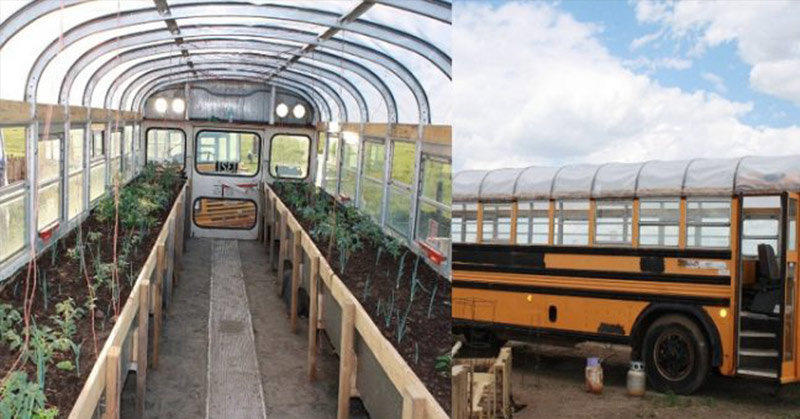Upcycling is the new recycling and we love it when old items are put to new use. This is made even better when that new use is equal parts creative, functional, and sustainable. That’s what makes these school bus greenhouses so undeniably cool.
School Bus Greenhouses
Doni Rae of Brooks, Alberta, Canada knows an opportunity when she sees one. An avid vegetable garden living in a country with a rather short growing season, she wanted a flexible and inexpensive way to allow her to start her plants sooner and enjoy her produce longer.
At auctions with her family, she found a couple of retired school buses for a good price when she thought that maybe those buses could be repurposed as greenhouses (1). A winter’s worth of work and two schoolbus greenhouses later. As it turns out, she was right.
The Making of School Bus Greenhouses
Rae and her family purchased the buses and all the materials at local auctions. They had two school buses: a full-length 72 passenger bus and a shorter 32 passenger bus. The first step for both buses was to rip out all of the seats, however, after that, the building process for each greenhouse bus was completely unique.
Read: Turf Houses, Eco-friendly Homes with a Viking Twist
The 32 Seater
The best part about the smaller greenhouse school bus is that they kept the drivetrain in so it can be completely mobile. Other details of the greenhouse include:
- 3, three-foot poly covered skylights
- These create a softer, more ambient light so that the greenhouse doesn’t get as hot inside.
- 3 x 13-foot floor-level, 16-inch beds on both sides of the aisles
- Having the beds on the floor allows them to grow taller plants that grow more produce. For example, tomato plants will grow up to 13 feet tall if given the chance.
The 72 Seater
The larger bus required a bit more work to have ready for planting. First of all, they did remove the drivetrain from this one to use for another project, so the larger school bus greenhouse is not mobile.
The family also had to cut off the rivets in order to remove both the exterior and interior tin roof of the bus, which was apparently quite challenging.
Other elements of the big greenhouse bus include:
- Oilfield pipe to create a flat side to attach the roof
- 6mm clear poly for the roof
- Soft plastic from an old walk-in freezer curtain stapled down overtop of the poly to protect it from windstorms, secured with boards on the inside.
- Recycled tin roof for the interior lining of the plant beds to prevent problems with rotting.
- 28 inch high raised plant beds that are 20 inches deep.
The clear roof of the large bus means that it gets much warmer inside this greenhouse than it does in the smaller bus.
Similarities
During their first spring, they used propane heaters for some of the earlier, cold spring nights, with plans of installing permanent natural gas heaters for subsequent seasons.
Both buses had their floors painted with pavement sealer to avoid rusting from watering the plants. In their first season, Doni Rae watered them with a regular garden hose but hoped to install drip irrigation for both.
The Benefits of School Bus Greenhouses
School Bus Greenhouses are sustainable, affordable, and as long as you leave the drivetrain in, moveable. Removing just the roofs of the buses and leaving the sides and therefore windows intact also has its advantages. There’s less heat loss from wind and ground exposure than a traditional greenhouse, but you can also open the windows to control temperature and ventilation if needed.
“As I’ve been getting more and more into commercial gardening, I’ve realized that these greenhouses are the best way to achieve a reliable harvest, stopping things like frost and hail from taking a toll,” Rae explains.
Keep Reading: Couple Lives Off The Grid After Spending 20-Years Building Self-Sustaining Floating Island
Sources
- https://www.farmshow.com/a_article.php?aid=32242

